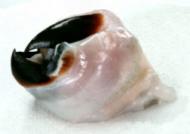- More than 2 years ago
A squishy squid has some chemical tricks that help it hold on to its tough, rigid beak without hurting itself.

Squids look soft and squishy — and for the most part, they are. Yet a squid’s beak — the rigid part of its mouth — is hard enough to snap a fish’s spine with just one bite.
Biting a bone in two requires considerable force. But how can the squid’s squishy soft mouth hold on to the beak without cutting itself against the beak’s rigid edge? Somehow, the soft tissues in the squid’s mouth must resist the force generated by the strong chomp.
It’s a puzzling question, somewhat like holding a bare razor blade with a block of Jell-O, says Herbert Waite. He’s a biochemist at the University of California, Santa Barbara who studies the molecules that make up structures like the beaks of squids and the jaws of marine worms.
Waite says a closer look at a squid’s beak reveals how the system works. He and his colleagues analyzed tiny pieces of material all the way from the beak’s tip to its base.
First, different parts of the beak have different degrees of hardness. The edge of the beak has a base that’s soft enough to not damage the squid’s delicate mouth tissues. The tip, where the bone crushing occurs, is about a hundred times harder. Between the base and the tip, the beak material becomes harder and harder.
Second, the chemical makeup of the beak also changes in different parts of the beak. This change in chemical composition accounts for the shifting degree of hardness from one end of the beak to the other.
The researchers found a certain protein in much higher levels in the rigid beak tip than in the softer edges. The protein controls how water wraps around another molecule in the beak, called chitin. Chitin is a carbohydrate that also makes up the outer skeletons of insects, shrimp and crabs.
Packing more of the protein around chitin squeezes out water molecules, Waite says. This allows the larger chitin and protein molecules to form many strong bonds, without water getting in the way. With more connections between these large molecules, the increased bonding produces harder beak tissue. And, because there is more of this protein at the beak’s tip, the tip is stronger and harder than the edges. In fact, the beak material is one of the hardest materials produced by a living organism.
Waite says the structure of these beaks could help engineers learn to design better medical devices.
For example, he says, the metals used in artificial joints are much harder than the bones surrounding them. A smoother transition between the rigid metal and softer bone could reduce wear and tear on artificial joints.
Power words:
Carbohydrate: A chemical compound made in green plants that is an important source of energy in food. Carbohydrates are made up of carbon, hydrogen and oxygen.
Chitin: The hard material that makes up the outer skeletons of the invertebrates known as arthropods, such as shrimp, crabs and insects. Chitin is a type of carbohydrate.
Force: Something that causes an object to move, change its shape, or change its speed or direction of movement.
Molecule: A group of two or more atoms that are joined together by sharing electrons in a chemical bond.
Protein: A molecule that is made of long chains of chemical compounds called amino acids. Living cells are made up largely of proteins. Proteins are also an important part of the diet for many animals.






